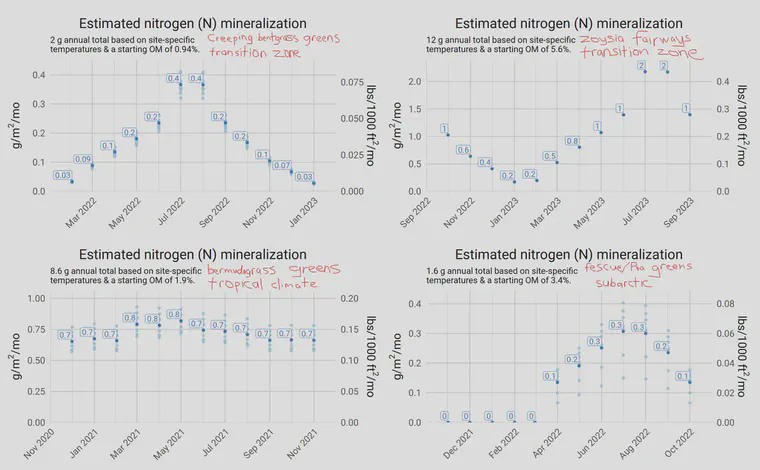Estimated nitrogen mineralization from soil organic matter
This topic—carbon in turfgrass soils—was the subject of a Frankly Speaking podcast episode. One of the topics host Frank Rossi spoke about with guests Drs. Claire Phillips and Alec Kowalewski was the nitrogen mineralized from soil organic matter. This is a fundamental topic and I recommend you listen to this episode.
At about 26:50, Frank asked this:
“Can you imagine a system where simply having water available to keep that soil functioning [would provide enough N to the grass]?”
That’s a good question, and it depends on both the organic matter content of the soil and on the site temperatures.1
On the ATC soil tests, I make a calculation of expected N mineralization for the upcoming year, broken down into monthly subtotals, based on the quantity of soil organic matter on the most recent soil test and on the site-specific temperatures. This figure shows how this tends to be, for recent soil tests at four distinct locations. I’ve selected these sites to show a range of soil organic matter content and temperatures.

I’ll start at the top left and go plot by plot, describing some of the things that stand out to me.
0.94% soil organic matter, creeping bentgrass greens in the transition zone
These samples were collected in January 2022 so the estimated N mineralization was calculated starting in February 2022. Even for sand-based putting greens, a soil organic matter content of less than 1% is below average. There are high temperatures in summer at this location and there could be plenty of mineralization, but there just isn’t enough soil organic matter to have much N mineralized. The total annual mineralization estimate is 2 g N/m2 (0.4 lbs N/1000 ft2), and 40% of that is expected to happen in the two hottest months at that location—July and August.
5.6% soil organic matter, zoysia fairways in the transition zone
These samples were collected in September 2022 so the estimated N mineralization was calculated for the upcoming 12 months starting in October 2022. With this much soil organic matter, and in these temperatures, there is an estimated mineralization of 12 g N/m2 (2.4 lbs N/1000 ft2). For manilagrass (Zoysia matrella) fairways at this site, I expect that could be enough N to produce the required type of surface.
3.4% soil organic matter, fescue/Poa greens in the subarctic
These samples were collected in October 2021 so the estimated N mineralization was calculated for the upcoming 12 months starting in November 2021. Even though the average soil organic matter of these soils is 3.4%, which is relatively high for sand-based putting greens, there is only 1.6 g N/m2 (0.3 lbs N/1000 ft2) of annual mineralization expected because of the cool temperatures at this location. Notice the striking difference with the first transition zone location we looked at. This subarctic location has 3.6 times more soil organic matter than does the transition zone location, but expects less annual N mineralization because of low temperatures.
1.9% soil organic matter, bermudagrass greens in a tropical climate
These samples were collected in November 2020 so the estimated N mineralization was calculated for the upcoming 12 months starting in December 2020. The annual total here is estimated at 8.6 g N/m2 (1.7 lbs N/1000 ft2) and the amount expected to be mineralized each month is relatively constant through the year. The tropical temperatures are consistently high. There are not the summer peaks and winter drops like we can see at the other locations.
I recommend making this calculation and considering the estimated N mineralization before planning fertilizer applications.
I’ve written about this before. See the related posts below, or the posts tagged nitrogen to see more explanations. ↩︎